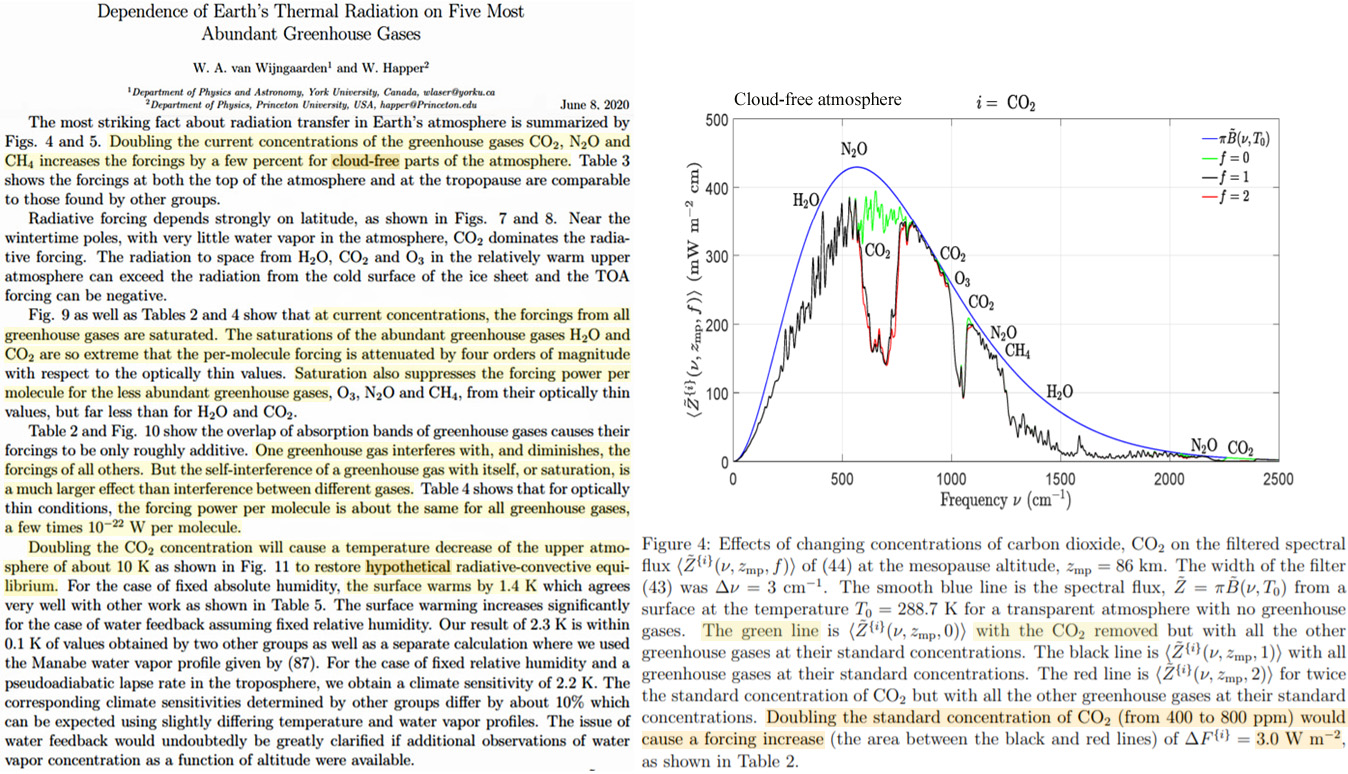A new analysis by Drs. Wijngaarden and Happer (2020) suggests the “self-interference” saturation of all greenhouse gases in the current atmosphere substantially reduces their climate forcing power.
At the current concentrations, the forcing power for greenhouse gases like CO2 (~400 ppm) and CH4 (1.8 ppm) are already saturated. Therefore, even doubling the current greenhouse gas concentrations may only increase their forcings “by a few percent” in the parts of the atmosphere where there are no clouds. When clouds are present, the influence of greenhouse gases is even further minimized.
While the “consensus” model view is that doubling CO2 from 280 ppm to 560 ppm results in a surface forcing of 3.7 W/m², Wijngaarden and Happer find doubling CO2 concentrations from 400 to 800 ppm increases climate forcing by 3 W/m². This warms the surface by 1.4 K as it “hypothetically” cools the upper atmosphere by 10 K.
Equilibrium climate sensitivity (when positive feedback with water vapor is included) is identified as 2.2 K, which is within 10% of multiple other analyses.






The 1.4 C is about 2.5 F°. Nice. I can count on tomatoes ripening.
However, while Gaia may figure out how to get to 800, it doesn’t look like human use of carbon based fuel will be an important factor. All of the issues regarding RCP8.5 apply to this “800” level, and that’s a can of worms.
In Massachusetts I used to have to pick buckets of green tomatoes the night before a forecast frost. They would ripen over then next couple of months, and yield about as many as I now get in Florida for the entire growing season But, yeah, you’d get a lot more if it were warmer where you are.
Does that mean we are doomed or not?
I guess you missed this line where they point out that it’s not 1.4K but rather 2.3K when only taking change in radiative forcing including water vapor feedback (ignoring all other forms of feedback):
“Doubling CO2 concentrations with water vapor feedback increases the surface temperature warming to ∆θ0 = 2.3 K from ∆θ0 = 1.4 K, or by a factor of 1.6.”
The “water vapor feedback” increase from 1.4 to 2.3 K wasn’t “missed”. In fact, the last sentence says this:
“Equilibrium climate sensitivity (when positive feedback with water vapor is included) is identified as 2.2 K, which is within 10% of multiple other analyses.”
Did you miss that?
The title refers to the effect of CO2 by itself.
And yet, your title improperly implies they said that it only contributes 1.4C of warming.
The title clearly refers to CO2 only. The last sentence refers to the equilibrium climate sensitivity guess. A title can only be so long.
There is no proof of Moisture feedback.
There is evidence that it is negative.
https://www.youtube.com/watch?v=Y2K1uHvfaek
Yes, I should have included positive.
Surface warming contemporaneous with stratospheric cooling can be seen in the UAH satellite data set, tlt vs tls (lower troposphere vs lower stratosphere).
https://www.nsstc.uah.edu/data/msu/v6.0/tlt/uahncdc_lt_6.0.txt
https://www.nsstc.uah.edu/data/msu/v6.0/tls/uahncdc_ls_6.0.txt
I consider this material evidence for an increase in the resistance to outward heat transmission over time. This might be termed the “Greenhouse Effect” and might be plausibly attributed to CO2. As always, models wanting validation remain suspect.
Beware of correlations : they does not mean causation.
The stratospheric cooling might very well be induced by less O3 formation due to a decreasing in UV irradiation (3O2 + UV -> 2O3) or by any other stratospheric phenomenon which may have little or nothing to do with the lower tropospheric warming (mostly related to sea surface temperature variations, AMO, PDO, ENSO, cloudiness, etc.).
Istn’t the hypothesis that CO2 warming raises the height at which radiation escapes and yet the atmosphere is shrinking and the upper regions cooling.
There seems to be a slight disconnect somewhere.
Thanks. I hadn’t been following if the atmosphere were contracting or expanding, but, if as you write it’s contracting, that should be yet another problem for warmists.
Manabe and Möller calculated the annual radiative heat budget based on seasonal, latitudinal, altitudinal observed temperature distribution (see Heat budget chapter p. 525) :
https://www.researchgate.net/publication/278665889_On_the_radiative_equilibrium_and_heat_balance_of_the_atmosphere
They conclude that CO2 and H2O have a cooling effect due to long wave radiation even in the troposphere.
At least someone is wrong.
So this is clear sky through a selected area of earth and atmosphere as a ?static outcome.
Clouds mean that this effect in clear sky is reduced by 50 % ? or an uncertain % ?
The whole earth effect on a rotating sphere is ? still 2.2 K?
Good to have detail of the intricacies but what is the resultant real world Milankovitch, rotating, cloud covered outcome please?